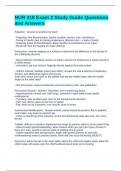NUR 218 Exam 2 Study Guide Questions
and Answers
Palpation - Answer-to examine by touch
- Fingertips: fine discrimination, pulses, position, texture, size, consistency
- Dorsal of hands: best for feeling temperature (thinnest skin --> back of hand)
- Grasping action of thumb/fingers: detect position & consistency of an organ
- Bimanual: best for trapping an organ (kidney)
Percussion - Answer-tapping on a surface to determine the difference in the density of
the underlying structure
- Direct method: immediate; assess an adult's sinuses for tenderness & elicits sounds in
a child's thorax
- Instruction: tap your hand or fingertip directly against the body surface
- Indirect method: mediate (used more often); reveals the size & density of underlying
thoracic and abdominal organs and tissues
Instruction: place one hand on the patient and tap the middle finger with the middle
finger on the other hand
- Fist Percussion: assess tenderness over the kidneys, liver, and gallbladder
Percussion Sounds - Answer-- Resonant: over normal lung tissue
- Hyperresonant: normal over child lungs, abnormal in adult (which may signify
emphysema)
- Tympany: over air-filled sacs such as the stomach and intestines
- Dull: over dense organ as the liver or spleen
- Flat: when no air is present, over muscle, bone or tumor
Assessment Modifications - Answer-Infants: parent should be present, flat on padded
exam table, may keep on parents' lap
- Listen to heart/lung when sleeping, do the last distressing steps last (eye, ear, nose,
throat)
Toddler: difficult to examine, frightened and clings to parents, allow to sit on parent's lap
- Allow to keep special blanket/toy, allow choices when you can (don't give choices if
there isn't one), parent to remove parts of clothing one at a time
- Gather objective data during history, begin with games (Denver II) start with
nonthreatening areas & proceed slowly; finish with the most distressing (HEENT)
Preschool: either the lap or the exam table, talk to the child and explain steps, allow the
child to play with equip, give the child feedback about what you're hearing
, - Start with thorax, abdomen and extremities, genitalia then the HEENT
School-age: use more sophisticated language, examine on table, allow them to decide
whether parents should stay or go, allow them to keep on underwear with cover sheet
- Discuss function of the body, progress from head to toe (as with the adult)
Adolescent: sitting on the exam table, exam the child without the parent present
- As the body is changing fast, give child feedback about their developing body
- Take the opportunity to teach as this age is ripe for teaching
- Head to toe assessment with genitalia last and rapid
Aging Adult: sitting or lying on exam table, allow rest and try to arrange so there are few
position changes, slow paced, use physical touch as long as it's okay with the patient
- Do not mistaken decreased hearing/visual acuity for confusion
General Survey - Answer-A study of the whole person, covering the general health state
and any obvious physical characteristics. Gives an overall impression of the person.
- Physical Appearance, body structure, mobility, behavior
Pain - Answer-- An unpleasant sensory and emotional experience associated with
actual or potential tissue damage
**Subjective Experience**
- Infants: have the same capacity for pain as adults --> high risk for under treatment of
pain
Aging Adults: pain is not a normal process of aging --> pain is under treated
Gender Differences: societal expectations of men
Transcultural Considerations: different language --> increased misunderstandings,
underreporting, and under treating
Nociceptive Pain - Answer-the response of the nervous system to painful stimuli
- Cutaneous: skin/superficial tissues (cuts, minor burns, lacerations)
- Somatic: musculoskeletal tissues or body surface
o Described as sharp, aching, throbbing, and localized
- Deep Somatic: ligaments, tendons, bones, blood vessels, nerves (sprains/fracture)
- Visceral: deep hollow organs not well localized (GI/GU tract, gallbladder) or
(inflammation in an area, pancreas); tumor involvement/obstruction, intestine




